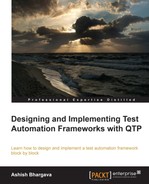Book Description
With test automation becoming the norm, this is an essential course in framework designing with QTP. Mixing conceptual and practical elements, it imparts all the know-how you need to implement the framework.
- A simple and easy demonstration of the important concepts will enable you to translate abstract ideas into practice
- Each chapter begins with an outline and a brief statement of content to help the reader establish perspective
- An alternative approach to developing generic components for test automation
In Detail
As software testing is maturing, the focus is shifting towards test automation. The key is to learn and grow skills in framework designing and start contributing to project organization goals.
Through a helpful mix of conceptual and practical aspects, you will learn everything you need to know related to the implementation of frameworks using QTP. Through simple examples, you will gradually develop the skills needed to execute concepts and code blocks used to design and implement the test automation framework.
This tutorial-based guide demonstrates an easy way to implement concepts to create a portable framework across the various versions of QTP. You will learn about the automation lifecycle and gradually develop technical concepts related to each phase. Within a short amount of time, you will be able to deal with challenges in test automation. "Designing and Implementing Test Automation Frameworks with QTP" uses a simple, yet elegant approach and gives the reader all the skills and knowledge they need to implement the framework.
Table of Contents
- Designing and Implementing Test Automation Frameworks with QTP
- Table of Contents
- Designing and Implementing Test Automation Frameworks with QTP
- Credits
- About the Author
- Acknowledgments
- About the Reviewers
- www.PacktPub.com
- Preface
- 1. Automation Life Cycle and Automation Goals
- The test automation life cycle
- Feasibility study
- Tool induction for automated testing
- Defining a test automation strategy
- Creating a automation test plan
- Script design and development
- Deployment, release, and maintenance
- Tool selection
- Tool selection criteria
- Processes
- Design, architecture, and documentation
- Automation goals
- Best practices
- Summary
- The test automation life cycle
- 2. Essentials of Automation
- About QTP
- The QuickTest object model
- Test objects
- Object repositories
- Record and replay
- Script development
- Analyzing an application
- Creating OR (adding test objects to OR)
- Adding a test step
- Enhancing scripts
- Summary
- 3. Basic Building Blocks for Creating Frameworks
- 4. Understanding and Creating Frameworks
- Programming with VBScript
- Introducing frameworks
- Introduction to the data-driven framework
- Introduction to the modular framework
- The keyword-driven framework
- The hybrid framework
- Business Process Testing
- Application-independent framework
- Summary
- 5. Deploying and Maintaining Frameworks
- 6. DOM- and XPath-based Framework in Web Applications
- Document Object Model
- HTML DOM
- JavaScript and DOM
- Finding HTML elements
- Finding HTML elements by ID
- Finding HTML elements by tag name
- Finding HTML elements by name
- Finding HTML elements by className
- Changing the HTML content
- Changing the HTML attribute
- Changing the HTML style
- Responding to an event
- Creating new HTML elements
- Removing an existing HTML element
- DOM and QTP
- Using XPath
- Summary
- Document Object Model
- 7. Capturing the Lessons Learned
- Index
